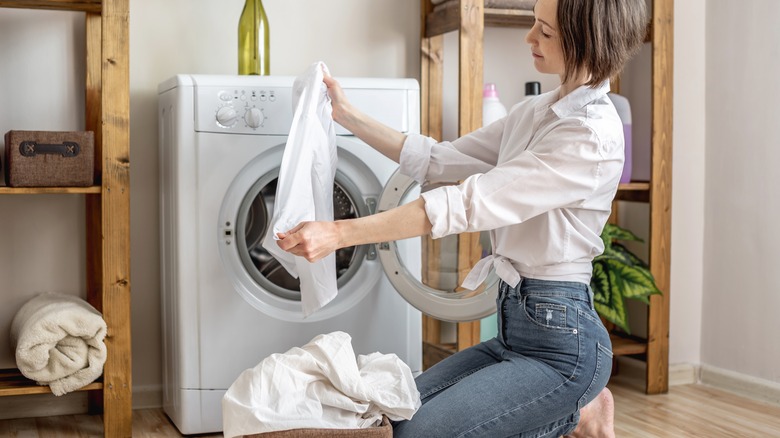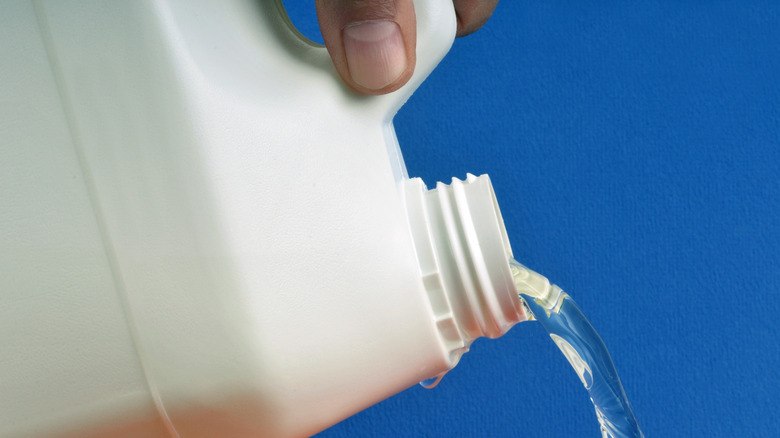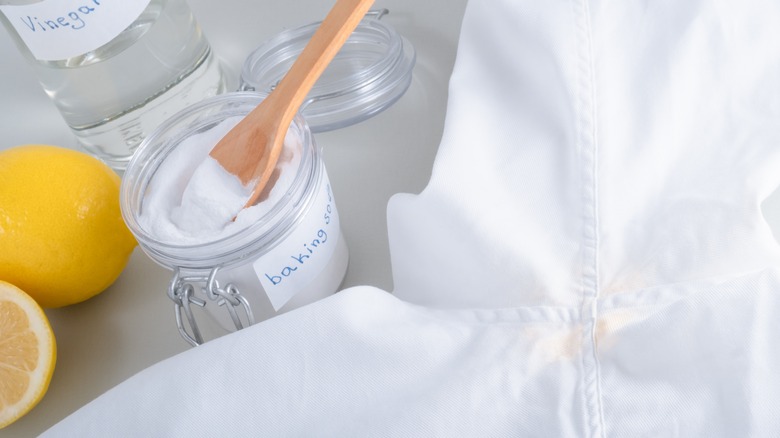Bleach Vs. Baking Soda: Here's When You Should Use Each For The Brightest Whites
Bleach is the laundry version of duct tape. It can fix almost all your problems when it comes to your white items and has become the go-to for stains, lightening, and refreshing white clothing and linens. However, while bleach is certainly one of the strongest options to clean fabrics, baking soda has also earned a spot in the laundry room thanks to its whitening and brightening powers.
The biggest question, then, is when should you use bleach or baking soda for the best outcome? The short answer is that while each product serves its purpose to enhance your white fabrics, bleach should be used to fight stains and super yellowed clothing or linens and baking soda is better for maintenance in daily loads. The longer answer has to do with how they work to whiten fabrics.
Bleach should be used for tough stains and discoloration
White clothing actually leaves the factory with bleach already applied, as most fabrics have a gray tinge when they are created. Cotton, synthetics, and wool do not look white upon completion when they are turned into clothing. In order to brighten these items and make them appear "super white," companies first bleach them and then add bluing. This creates a finish that is so stark that the human eye acknowledges it as the truest shade of white. However, over time, this process fades, leaving white clothing and linens a dingy color or an off-white shade. Bleach helps to counteract this by pulling up stains and yellow discoloration, thanks to ingredients like sodium hypochlorite. Adding bleach to a load of laundry or soaking your whites before washing will get most fabrics back to the bright color associated with new clothes.
While the pros of using bleach to clean your clothes are obvious, some prefer to avoid harsh cleaners, and this liquid is one of the most abrasive. The more you use it on certain pieces, the shorter amount of time they will last with such a caustic product creating wear and tear on the fibers. While it is useful for intense stains and spills, if you can wash items without bleach to brighten them, it's better to reserve this option for tough dirt, yellowing, and marks. However, some stains are made worse by bleach, like rust, so avoid using it for this.
Baking soda can be used as regular laundry maintenance
On the other hand, baking soda has become the unsung hero of the home, and its natural elements make it a preference for anyone who wants to avoid harsh chemicals as much as possible. It is an alkaline substance that is known for breaking up odors and balancing pH levels as well as working out hard water stains and other messes. The same ingredients that combine inside baking soda to clean countertops, bathroom fixtures, and your kitchen also work to remove oils and acids that the human body can transfer onto clothing.
If you want to use baking soda on your whites, keep in mind it is more of an aid to brighten fabrics that are already a solid white color. The powder acts as a scrub to lift dirt, though it doesn't "erase" all stains the way bleach can. It can help with discoloration but usually works best on clothing or linens that aren't extremely dingy or stained. Baking soda is fine to use in your general laundry loads, so you can include it with every wash as a preventative and a booster to keep whites white and brighten them before they get too discolored.
When using baking soda, you can either mix a few scoops with water and soak clothing to help remove oil and other acids — which also helps remove unpleasant laundry odors — or you can add ½ cup to 1 cup to your load. Just avoid putting it in the detergent dispenser, otherwise you might encounter a clog.


